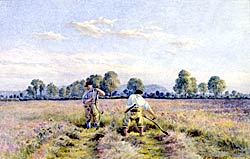
 |
Scything grass in the Meadows, Nottingham, by S W Oscroft. (© Nottingham City Museums and Galleries; Nottingham Castle). |
Overview
Farming is the basis of human existence. The land of Nottinghamshire has been farmed for as long as man has colonised the countryside. In the medieval period the county was dominated by open field agriculture along the Trent Valley, and rather less intensive methods on the thin sandy soils of the Sherwood Forest area. Nottinghamshire was subject to piecemeal enclosure from the seventeenth century onwards, and extensive Parliamentary enclosure in the course of the eighteenth and nineteenth centuries. Laxton, roughly in the centre of the county, remains the only surviving example of an English village in which the open field system survives. It has a Visitors' Centre and can be visited by individuals and by school parties.
For brief introductions to agriculture see:
- Philip Lyth, A History of Nottinghamshire Farming (1989)
- [Nottinghamshire Food and Farming Year Committee], Aspects of Nottinghamshire’s agricultural history (1989)
For a detailed study of Laxton see
- John Beckett, A History of Laxton: England’s Last Open Field Village (1989).